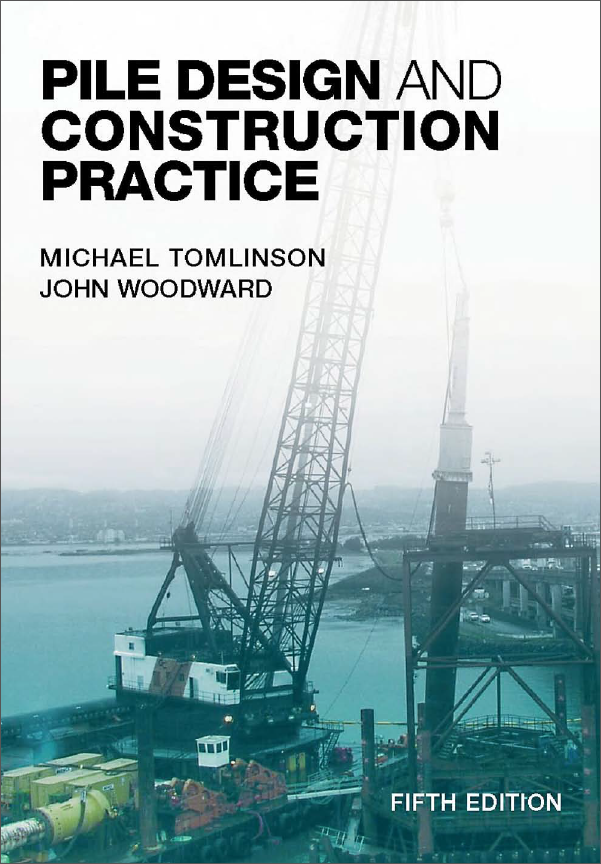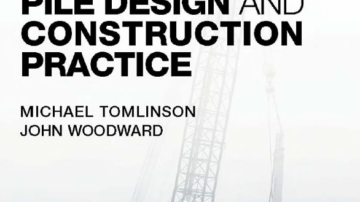This post is on the useful book written by Michael Tomlinson & John Woodward.
Piling is both an art and a science. The art lies in selecting the most suitable type of pile and method of installation for the ground conditions and the form of the loading. Science enables the engineer to predict the behaviour of the piles once they are in the ground and subject to loading. This behaviour is influenced profoundly by the method used to install the piles and it cannot be predicted solely from the physical properties of the pile and of the undisturbed soil. A knowledge of the available types of piling and methods of constructing piled foundations is essential for a thorough understanding of the science of their behaviour. For this reason the author has preceded the chapters dealing with the calculation of allowable loads on piles and deformation behaviour by descriptions of the many types of proprietary and non-proprietary piles and the equipment used to install them.
In recent years substantial progress has been made in developing methods of predicting the behaviour of piles under lateral loading. This is important in the design of foundations for deep-water terminals for oil tankers and oil carriers and for offshore platforms for gas and petroleum production. The problems concerning the lateral loading of piles have there-fore been given detailed treatment in this book.
The author has been fortunate in being able to draw on the world-wide experience of George Wimpey and Company Limited, his employers for nearly 30 years, in the design and construction of piled foundations. He is grateful to the management of Wimpey Laboratories Ltd. and their parent company for permission to include many examples of their work. In particular, thanks are due to P. F. Winfield, FIStructE, for his assistance with the calculations and his help in checking the text and worked examples.
Piling rigs are a commonplace feature on building sites in cities and towns today. The continuing introduction of new, more powerful, and self-erecting machines for installing piled foundations has transformed the economics of this form of construction in ground conditions where, in the past, first consideration would have been given to conventional spread or raft foundations, with piling being adopted only as a last resort in difficult ground.
The increased adoption of piling is not only due to the availability of more efficient mechanical equipment. Developments in analytical methods of calculating bearing capacity and dynamic methods for load and integrity testing have resulted in greater assurance of sound long-term performance. Further economies in foundation and superstructure design are now possible because of the increased ability to predict movements of piles under load, thus allowing engineers to adopt with confidence the concept of redistribution of load between piles with consequent savings in overall pile lengths and cross-sectional dimensions, as described in this new edition.
Since the publication of the fourth edition of this book, Eurocode 7, Geotechnical Design, has been issued. As the name implies this code does not deal with all aspects of foundation design; there are extensive cross-references to other Eurocodes dealing with such matters as the general basis of design and the properties of constructional materials. The Code does not cover foundation design and particularly construction as comprehensively as the present British Standard 8004 Foundations, and the British National Annex to Eurocode 7 is yet to be published. The authors have endeavoured to co-ordinate the principles of both codes in this new book.
The authors are grateful to Professor Richard Jardine and his colleagues at Imperial College and Thomas Telford Limited for permission to quote from their book on the ICP method of designing piles driven into clays and sands based on extensive laboratory research and practical field testing of instrumented piles. Their work represents a considerable advance on previous design methods. The authors also gratefully acknowledge the help of Mr Ian Higginbottom in checking the proofs and Mr Tony Bracegirdle of the Geotechnical Consulting Group for his helpful comments on the application of Eurocode 7 to the design of piles and pile groups.
Many specialist piling companies and manufacturers of piling equipment have kindly supplied technical information and illustrations of their processes and products. Where appropriate the source of this information is given in the text.

Download Link- Pile Design & Construction
Disclaimer: The pdf found in internet as free. If the author has any objection,then comment below so that we will remove the post.

Leave a Reply
You must be logged in to post a comment.